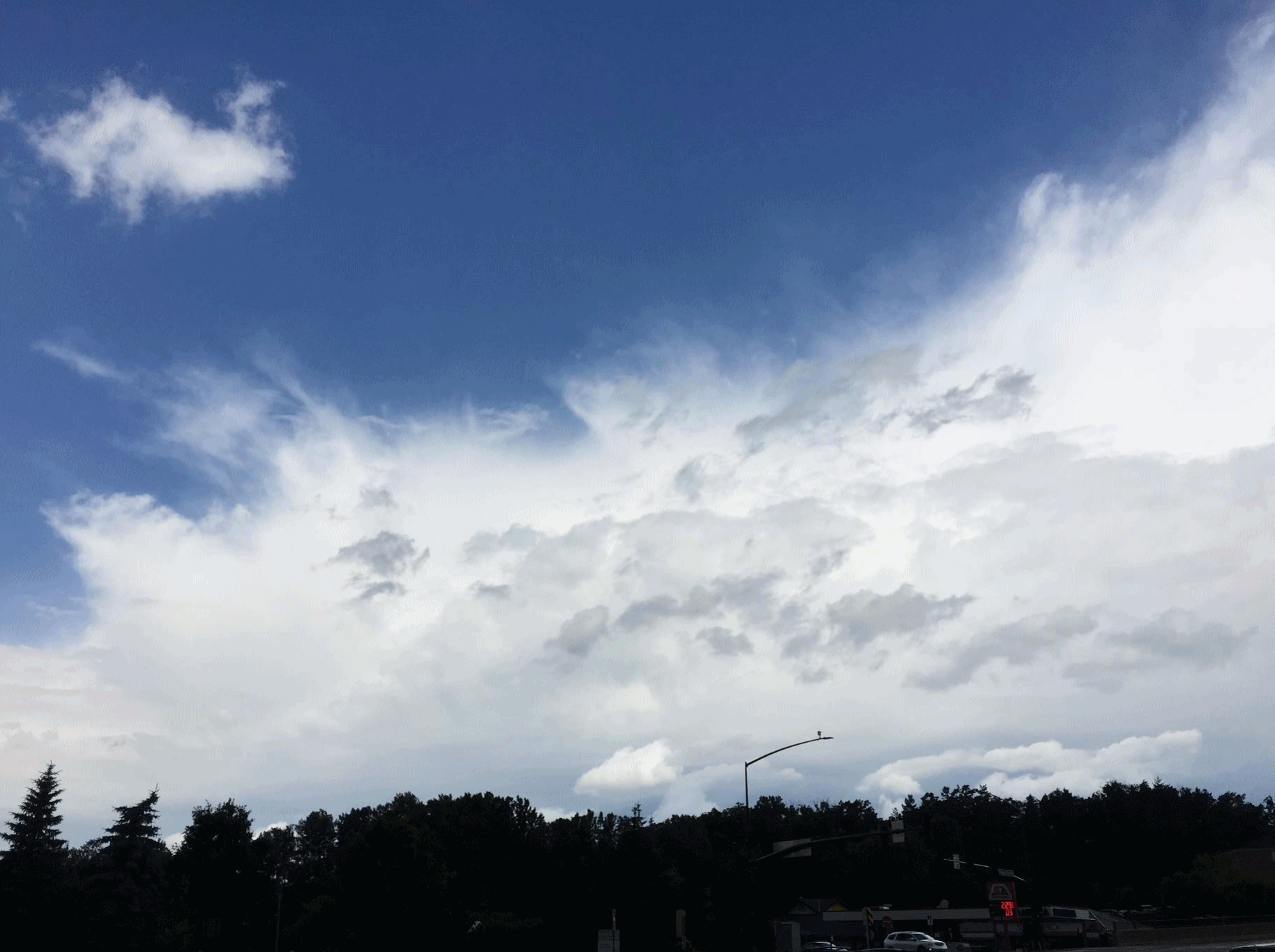79 F. high in the Twin Cities Thursday.
83 F. average high on June 30.
77 F. high temperature reported on June 30, 2015.
.10" rain fell at KMSP yesterday.
July 1, 1964: Tyler picks up over 6 inches of rain in 24 hours.
 It's a Miracle: A 4th of July Weekend To Remember
It's a Miracle: A 4th of July Weekend To RememberTalk
about great timing: a fresh transfusion of cool, comfortable Canadian
air sets the stage for an amazing stretch of weather into
Monday. About as good as it gets at this latitude.
Good news for humanoids, but chances are your favorite canine friend will be very stressed into next week. A recent
New York Times article
suggested at least 40 percent of dogs suffer from "noise anxiety". They
run away, hide, jump into laps - in a desperate attempt to get away
from flashing lights and noise. A worst-case scenario is fireworks AND
thunder.
It seems dogs may be extra-sensitive to winds and
electrical fields within a T-storm. Make sure they have a "safe spot",
as shielded as possible from booming explosions.
I'm happy (and somewhat amazed) to be able to predict a lack of atmospheric firecrackers into
Monday,
with the possible exception of the Red River Valley. Comfortable
September-like air today gives way to slow warming over the weekend;
just warm enough for the lake, beach or pool. Mid 80s are expected on
the 4th; maybe 90F by midweek.
A dry pleasant
4th of July weekend? Miraculous!
Slow Warming Trend Into Next Week.
Plan on 70s today and Saturday, with 80s returning Sunday and the 4th
of July. By the middle of next week it will feel like prime-time
summertime again, according to both NOAA and ECMWF guidance (above).
Graphic: WeatherBell.
 Accumulated Precipitation by 1 PM Sunday
Accumulated Precipitation by 1 PM Sunday.
NOAA models continue to hint at a few spotty, convective showers and
T-showers over the Red River Valley Saturday and Sunday PM, and a few of
these could, in theory, drift into the Brainerd Lakes area. Most towns
and lakes should stay dry into Monday thought, which is nothing short of
Divine Intervention. 4 KM NAM (WRF) precipitation outlook: NOAA and
AerisWeather.
Light Winds into Sunday.
Sustained, surface-level winds generally remain under 10 mph into
Monday morning, picking up from the south to southeast a bit on the 4th
of July. Light winds, sunshine, low humidityh, lukewarm temperatures -
what's not to like? Graphic: Aeris Enterprise.
Steamy Heat Levels Return Next Week.
Although I still don't see an extended streak of 90s for Minnesota, the
combination of heat + dew points in the 70s may push the heat index to
or above 100F by the middle of next week.
One Graph Reveals How Much Global Temperatures Have Spiked Since 1880.
Science.Mic has the details; here's the intro: "
Every single month this year has broken a temperature record, and it's putting 2016 on track to be the hottest year on record since the National Climatic Data Center. Bloomberg has created an incredible animation that shows how global temperatures have risen above the pre-Industrial Age average. It's similar to the "doom spiral" that climate scientists created in May. You can see how the spikes in temperature get bigger and bigger over time..."
Graphic credit: Bloomberg.
2016 Will Be a Record-Breaker, And Not In a Cool Way. Here's an excerpt of a summary at
GOOD: "...
This May was the hottest on record since recordkeeping began 137 years ago, according to a newly released report by the National Oceanic and Atmospheric Administration
(NOAA). But that’s not all. The report also notes, “May 2016 marks the
13th consecutive month a monthly global temperature record has been
broken—the longest such streak since global temperature records began in
1880.” Overall, this puts 2016 on pace to be the hottest year ever..."
The Mysterious "Cold Blob" in the North Atlantic Ocean Is Starting To Give Up Its Secrets. Is this the result of accelerating melting of Greenland or just natural variability. Chris Mooney digs deeper at
The Washington Post: "
For
some time, scientists have been worried that something odd may be
happening in the North Atlantic Ocean. The reason is that in the past
several years, amid record warm global temperatures (2014, 2015 and 2016
seem likely to be the third-hottest, second-hottest and hottest years
on record, respectively), ocean temperatures to the southeast of
Greenland have often been quite cold.
Sometimes, according to temperature maps provided by the National
Oceanic and Atmospheric Administration, they have even shown record-cold temperature anomalies in and around a region known as the Irminger Sea..."
Greenbrier Resort Opens Doors to West Virginia Flood Victims. Here's an excerpt of a story at
Golf Digest: "
The
Greenbrier Resort was suppose to host the world's best golfers next
week. Instead, the White Sulphur Springs estate is serving as home to
victims of the deadly West Virginia floods. Though the resort is
officially closed, the hotel has opened a limited number of rooms to
those who have lost their homes. "Due to all of the damage we received
from the storm, we aren't able to provide The Greenbrier experience that
our guests expect," said Jim Justice, owner of the resort. "But we can
certainly provide a comfortable room for those who are hurting and need a
place to go..."
100 Severe Storm Warnings Issued by MPX Office.
The Twin Cities office of the National Weather Service has issued 100
severe storm warnings for its coverage area so far in 2016. That
compares to 548 warnings for the Oklahoma City Office, and no warnings
whatsoever in the Anchorage and Honolulu offices. Map credit: Iowa
Environmental Mesonet.
Millions of Caterpillars Are Decimating The Trees in New England. Angela Fritz reports at
Capital Weather Gang: "
When
the European gypsy moth hatches, it is born as a furry little
caterpillar. They emerge from their eggs in the spring and proceed to
feed mercilessly on the surrounding foliage. Tree leaves and coniferous
needles are the primary target of this tiny scourge, and if you happen
to live in the middle of an infestation, you may feel as if the
plague has descended on your own home. This is what’s happening in New
England. Caterpillars are everywhere, trees are decimated, and the
skyline looks like the middle of winter..."
Photo credit: "
This photo was taken on June 28. In other words, these trees should have leaves." (Phil Burt/CapeCodWeather.net).
Satellite Images Show Glacier Park's Ice Fields Shrinking.
Billings Gazette in Montana has the story and interactive (before/after) visuals; here's the intro: "
To
be a glacier, a field of ice must move. Seen from space, they also
appear to breathe. A pair of new animations from NASA’s Earth
Observatory compile three decades of satellite images that show Glacier
National Park’s landmarks shrinking as climate conditions change. But
seen in sequence, the alpine glaciers seem to inhale and exhale as
occasional big-snow years occur..." (Image: NASA).
 Hubble Captures Vivid Auroras in Jupiter's Atmosphere
Hubble Captures Vivid Auroras in Jupiter's Atmosphere.
NASA has the amazing details: "
Jupiter,
the largest planet in the solar system, is best known for its colorful
storms, the most famous being the Great Red Spot. Now astronomers have
focused on another beautiful feature of the planet, using Hubble's
ultraviolet capabilities. The extraordinary vivid glows shown in the new
observations are known as auroras. They are created when high-energy
particles enter a planet’s atmosphere near its magnetic poles and
collide with atoms of gas. As well as producing beautiful images, this
program aims to determine how various components of Jupiter’s auroras
respond to different conditions in the solar wind, a stream of charged
particles ejected from the sun..."
Image credit: "
Astronomers
are using NASA's Hubble Space Telescope to study auroras — stunning
light shows in a planet's atmosphere — on the poles of the largest
planet in the solar system, Jupiter." Credits: NASA, ESA, and J. Nichols (University of Leicester).
Report: With Planning Grid Can Handle More Electric Vehicles.
Midwest Energy News has the story: "
Much
of the nation’s vehicle fleet could be converted to run on
electricity with hardly a ripple felt by the power grid, according to
recent findings by the Rocky Mountain Institute. But a key factor is
whether utilities and other developers locate charging stations in
places that tap into the excess capacity now readily available on
the grid. Converting all of the nation’s “light” vehicles from gasoline
to electricity likely would hike the demand for power by about 25
percent nationwide, according to Chris Nelder, a manager with the Institute’s electricity practice. He is one of three authors of the study assessing the probable impact of vehicle charging on the grid..."
Photo credit: "
Researchers
say the power grid could handle the increased demand by electrifying
the U.S. vehicle fleet, though it would take utility planning."
Stem CTO: Lithium-Ion Battery Prices Fell 70% in the Last 18 Months. Here's a clip from a post at
Greentech Media: "...
But a few other large producers -- LG Chem, Panasonic and Samsung -- are already making batteries at unprecedented scale.
There are numerous giga-scale factories producing cells and battery
packs for electric cars and stationary applications throughout Asia. And
the recent wave of capacity is already impacting pricing in a big way.
According to Larsh Johnson, the chief technology officer of Stem, the
company is paying 70 percent less for lithium-ion batteries than it was
18 months ago. "It’s happening. The capacity is out there," said Johnson
in an interview. "The momentum continues..."
How Wearable Technology Could Change The Way We Think About Air Pollution. If your sport coat turns black that's probably a bad sign. Here's a snippet from
The Washington Post: "
...While
activists lobby for more stringent pollution-cutting measures around
the world, and policymakers grapple with how to write them, some
scientists and designers have turned to the power of innovative
technology to raise awareness and save lives with the help of wearable
pollution sensors. These sensors, while mostly not yet proven
or available on a mass scale, may be coming sooner than you think..."
Photo credit: "Artist
Kasia Molga’s “Human Sensor” project changes color and pattern in
response to the wearer’s breathing and the surrounding air quality." (Nick Harrison).
Americans Are Watching More TV and Working Less, New Federal Data Shows. Here's an excerpt from The Washington Post: "...
The
typical American spends nearly as much time watching TV (2 hours 46
minutes) as working (3 hours 31 minutes) on any given day.
Americans spend nearly twice as much time buying stuff (45 minutes) as
on child care (24 minutes). I can't stress enough that these numbers
are statistical averages. There are very few, if any, actual people
whose day looks like the one above. But, if you took literally every
single person in America age 15 or older, including students and
retirees and workers and the like, asked them how they spent their time
in a typical day, and averaged all of those numbers together, that's
what that mythical "average day" would look like..."
Facebook, a News Giant That Would Rather Show Us Baby Pictures.
Ironic - FB has morphed into the largest news site on the planet, but
it appears news is not much of a priority, according to a
New York Times story: "...
Though
it is couched in the anodyne language of a corporate news release, the
document’s message should come as a shock to everyone in the media
business. According to these values, Facebook has a single overriding
purpose, and it isn’t news. Facebook is mainly for telling you what’s up
with your friends and family. Adam Mosseri, the Facebook manager in
charge of the news feed, said in a recent interview that informing and
entertaining users was also part of the company’s mission. But he made
clear that news and entertainment were secondary pursuits..."
Apps To Make Your 4th of July Travel a Breeze. A post at
The New York Times had some helpful app-advice; here's an excerpt: "...
Gas Buddy
is a staple on best travel app lists, and that's because it works
really well. As you can probably guess from the name, this app acts as
your guide to finding gas stations near you and at a price you're
willing to pay. Prices are user-submitted, which means you can submit
them, too, and tend to be fairly reliable. It's certainly worth a
download if you're the kind of driver who likes to go until you're
running on fumes, or just like to grab the best deal. Free, for iOS and
Android. iExit is
designed to prevent some of the most infuriating road trip moments —
"Which exit!?" "Uh, the one we just passed." — by letting you know
what's coming up just off the highway ahead of you..."
Who Needs a Weather App When You Can Get This Weather Stick? Sticks don't take vacations or demand pay increases. Uh oh.
Atlas Obscura has details: "
A
thin twig that can predict the weather. Seems unlikely. But that’s
exactly the shtick behind the weather stick, a natural barometer of
sorts that you can nail to the side of your house, garage, or teepee. Around
16 inches long, the spindly stick will smile upwards in anticipation of
good weather (clear skies and sun), and deflect downwards before rain
or snow. No batteries required—and yes! “They Really Work”. But how, exactly? Not just any stick, it turns out, can serve as a weather stick..."
Image credit: "If the stick is deflecting upwards, the weather ought to be good." (Photo: Courtesy of Davis Hill).
Thursday Climate Data:
 TODAY
TODAY: Hello September! Bright sunshine, light winds. Winds: N 3-8. High: 74
FRIDAY NIGHT: Clear and comfortably cool. Low: 57 (40s up north!)
SATURDAY: Sunny, still spectacular. Risk of a shower or T-shower Brainerd Lakes into the Red River Valley. Winds: SE 5-10. High: 79
SUNDAY: Plenty of sun, lake-worthy weather. Winds: SE 8-13. Wake-up: 60. High: 81
4TH OF JULY: Sticky sunshine, probably dry. Winds: SE 10-15. Wake-up: 62. High: 84
TUESDAY: Humid, scattered T-storms. Winds: S 10-15. Wake-up: 67. High: 88
WEDNESDAY: Hot and sweaty, isolated storm. Winds: S 10-20. Wake-up: 69. High: 90
THURSDAY: Steamy, more numerous T-storms. Winds: SE 10-15. Wake-up: 72. High: 87
Climate Stories...
Are West Virginia's Floods The Result of Climate Change? Did an increase in water vapor increase the odds of another 1-in-1,000-year flood? Here's an excerpt from
Forbes: "
For
a state that has been racked with recession and unemployment, the flash
floods that have ravaged West Virginia don’t help much. But the key
question to ask — no matter how unpleasant — is whether the coal sector
there shares some of the blame. At issue is the
concept of climate change and whether the warmer atmosphere is holding
more water and therefore intensifying the storms. To that end, West
Virginia’s prime industry has been coal, a fuel that when burned is
responsible for a third of all human-induced carbon emissions. Even
more, the surface mining that has occurred is lopping off whole
mountaintops and removing the vegetation, leaving the landscape
vulnerable to erosion..."
File photo credit: "In
this June 25, 2016, file photo, West Virginia State Trooper C.S.
Hartman, left, and Bridgeport W. Va., fireman, Ryan Moran, wade through
flooded streets as they search homes in Rainelle. A rainstorm that
seemed no big deal at first turned into a catastrophe for the small town
in West Virginia, trapping dozens of people whose screams would echo
all night." (AP Photo/Steve Helber, File).
The Paradox of American Farmers and Climate Change.
Many farmers I've talked to acknowledge the changes taking place in
their fields; some are hesitant to call it climate change - but I've run
into few farmers who deny that something is going on. Here's an excerpt
from
Fortune: "
There’s
a strange paradox in the world of agriculture: farmers are perhaps the
segment of the population most affected by climate change, and yet a
significant number of them don’t believe in it—especially the notion
that it’s man-made. I encountered this phenomenon as I reported a feature for Fortune on how agricultural giant Monsanto
is attempting to help farmers both mitigate their impact on the
environment and adapt to climate change. All the farmers I talked to
readily acknowledged that the weather patterns governing growing seasons
had been turned upside down in recent years, but I was on the receiving
end of a lot of eye rolls whenever I brought up climate change..."
Photo credit:
Ryan Donnell for Fortune Magazine.
 Combating Climate Change Crucial to Global Security.
Combating Climate Change Crucial to Global Security. This Op-Ed at the
San Diego Union-Tribune resonated; here's an excerpt: "...
Even more, let's honor their mission by preventing the very conflicts that they could be called upon to fight. To
do so, we must combat climate change. It’s not just an environmental
issue; it’s a global security crisis. The Department of Defense, in its
long-term planning documents, has identified climate change as an
“urgent and growing threat to our national security, contributing to
increased natural disasters, refugee flows, and conflicts over basic
resources.”
As a “threat multiplier,” climate change increases the likelihood of
conflict while also hindering military readiness. Like gas on a fire, it
inflames smoldering conflicts in regions least able to extinguish them.
That often means putting American service members in harm’s way...."
Science Groups to Congress: Climate Change is Real Threat. Here's the intro to a story at
AP:
"Thirty-one of the country's top science organizations are telling
Congress that global warming is a real problem and something needs to be
done about it. The groups, which represent millions of scientists,
sent the letter
Tuesday, saying the severity of climate change is increasing and will
worsen faster in coming decades. Eighteen groups sent a similar letter
in 2009. But Rush Holt, chief executive officer of the American
Association for the Advancement of Science, said the climate problem has
increased and scientists are even more confident about the harm..." (a
PDF of the letter is
here).
Louisiana's Vanishing Island: America's First Climate Refugees.
Actually that dubious honor may go to Native Americans living in
coastal Alaska, where beach erosion has forced some towns to resettle
farther inland. Here's a clip from
EcoWatch: "
Residents of a Louisiana island are among the first American climate refugees. Encroaching water
is forcing them off the land they have lived on for generations. Isle
de Jean Charles, Louisiana, has been inhabited by tribal communities
since the Trail of Tears era. The island, which used to be the size of
Manhattan, has lost 98 percent of its land over the last 60 years, MSNBC
reported..."
How One Virginia City is Re-Framing Sea-Level Rise as an Opportunity. Threat, and opportunity? Borrow a page from the Dutch? Here's an excerpt from
PRI: "...
Globally, a 2014 study
found the cost of protecting the world’s shoreline could reach into the
tens of billion of dollars a year by the end of the century. And in
Norfolk, Vernon isn’t the only one who sees climate change as an
opportunity. The region’s universities are trying to position themselves
as experts in dealing with sea level rise. The city’s 2015 resilience plan includes
an economic strategy. “The half-empty glass is we’ve got the highest
sea-level rise on the east coast and we’re soggy,” said Skip Stiles,
head of the Norfolk-based conservation group Wetlands Watch. “The half
full glass is if we fix it, we can make money off of it...”
Photo credit: "
Hurricane
Sandy sent 8-year-old Avery Solan out to play in the flooded streets of
Norfolk, Virginia, in October 2012. The city is trying to prevent worse
flooding as sea levels rise, and at the same time grow new industry in a
region currently dependent on military jobs."
Credit: Rich-Joseph Facun/Reuters.
Son of Famed Sherpa, Experts: Climate Change Rapidly Melting Everest.
VOA, Voice of America, has the story; here's an excerpt: "...
Although
six climbers, including one Sherpa, died during the 2016 season,
experts say the string of deadly avalanches and earthquakes that forced
repeated evacuations of the mountain, which claimed at least 40 lives
over the past 48 months, may not be a thing of the past. “It is
shrinking,” Dr. Nima Namgyal Sherpa, an Everest expedition organizer,
told VOA’s Tibetan Service via satellite phone from the Nepal-side
Everest base camp.“It's melting every year...”
Photo credit: AP.
"Trekkers make their way to Dingboche, a popular Mount Everest base camp, in Pangboche, Nepal, Feb. 19, 2016."


No comments:
Post a Comment